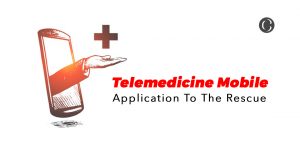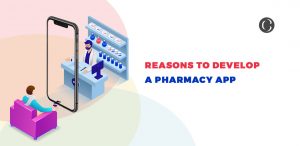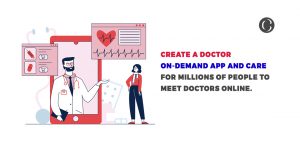Telemedicine Mobile App Development – The Succeeding Trend Shaping The Market

History has numerous instances of organizations and associations that didn’t detect significant changes, didn’t change their methodology, and thus, wound up out of date and unimportant.
A comparable move is occurring today in healthcare, yet there is more in question than a late expense. The healthcare industry needs to move and adjust to customer inclinations.
The COVID-19 pandemic has immediately affected the wellbeing of our nation and has additionally permanently changed how patients collaborate with the healthcare facilities.
Medical clinics and suppliers around the nation have needed to rapidly grow new methodologies to associate with patients and consent to social distancing rules, with an end goal to hinder the spread of the infection.
Predictable correspondence and openness are fundamental, particularly given the upsetting patterns in diminished preventive consideration visits and deferred crisis care. One arrangement is telehealth.
During this pandemic, we have seen that far off patient checking is significant for patients with a wide assortment of requirements: surely, those isolated with coronavirus, however, for solid patients as well – kids needing consistently planned well-kid visits and grown-ups who need routine consideration.
Numerous patients have encountered telehealth just because and many have positive impressions, with almost seventy-five percent of patients who had an ongoing telehealth visit portraying it as great or awesome, as indicated by an ongoing overview.
Significantly after the COVID-19 pandemic settles, these “transitory” approaches will, for all time, change persistent perspectives towards innovation and power healthcare providers to reexamine their way to deal with care.
Telehealth will stay a helpful choice and, now and again, an essential method to get care.
Installing telehealth into the standard act of care empowers suppliers to grow the entrance to individuals who in any case may swear off consideration and to individuals who may confront hindrances getting to a facility, for instance, patients with firm occupation calendars or constrained transportation.
Patients and providers are not by any means the only individuals are perceiving the advantages; government authorities are as well.
While repayment rules were incidentally extended to incorporate telehealth, a few states, for example, Colorado and Idaho, are making COVID-19 telehealth extensions changeless.
6 Trends moulding the future of Telehealth
1. Increasing Acceptance of Telehealth as a Trend in Standard Of Care: Clinical imaging was the primary field to completely grasp telemedicine patterns.
Clinical experts have depended on significant distance transmission of imaging for over four decades.
In its outset, the training was alluded to as “teleradiology”: sending x-rays from facility to facility for quick use and investigation.
This training is so basic today that the term is scarcely perceived; it’s become a de facto standard in practically all emergency clinics.
Today, x-rays, CT scans, MRI results, and other data is routinely shared by clinical experts isolated by hundreds or even a great many miles.
As this sort of sharing turns into the standard as opposed to the special case, one can hope to see it tended to and accepted in the guidelines which administer medicinal services at the state and government levels.
2. Reduced Reliance on Reimbursement Models: Reimbursement was the standard method to pay for telemedicine before, yet that is probably going to change pushing ahead.
Medicinal services are not, at this point given just by free doctors and foundations; present-day experts are commonly administered by responsible consideration associations, oversaw care gatherings, and other huge concerns.
Overseen care as of now represents in excess of seventy million patients in the United States – almost a fourth of the populace.
As leaders work in more prominent and more noteworthy good ways from neighborhood patients, the transmission of clinical information turns out to be increasingly essential.
This will prompt its assimilation into the “overhead” of clinical costs as opposed to being treated as a different reimbursable.
3. International Collaboration: In its earliest stages, the utilization of telemedicine across national outskirts was moderately uncommon.
A couple spearheading good causes utilized it to permit significant distance examination of clinical information and more prominent access to clinical consideration.
Since overall information transmission systems are considerably more strong and clinical guidelines have developed acquainted with telemedicine, the foundation is set up to convey much better clinical consideration to remote nations.
While there are unquestionably still issues to survive, (for example social predisposition, exchange strategies, installment plans, innovation norms, and universal affirmations and guidelines) the benefit capability of significant distance medication is getting huge.
The sheer prospects will lead human services suppliers to resolve the last challenges, making global medication a typical practice later on.
4. Peer Sharing Instead of Hub Sharing: The beginning of telemedicine saw government-bolstered programs built up all through the United States.
As a rule, these systems used a brought together “center point” model in which data was gathered from a wide region and taken care of to a significant clinic for use.
Later on, however, increasingly more correspondence will happen straightforwardly between singular human services offices.
These “distributed” systems are jumping up in which equivalent accomplices consolidate to share their far off clinical assets.
Models incorporate the Ontario Telehealth Network and the Arizona Telemedicine Program.
5. Mobile Health: Usually alluded to as mHealth, Mobile Health is one of the most energizing new patterns in telemedicine.
The chance of generally disseminating clinical data to people (the two professionals and patients) utilizing portable innovation is amazingly encouraging.
The conceivable outcomes are immense and empowering, despite the fact that a careful comprehension of how these projects should function (and be paid for) is still years away.
The proceeding with the development of remote correspondences innovation will without a doubt help bring mHealth activities to develop in the years to come.
6. New Remote Clinical Services: Since radiology has demonstrated to be such a powerful field for redistributing through telemedicine, numerous medical clinics are currently taking a gander at the chance of separating numerous different specializations.
Psychiatry, nervous system science, and numerous different controls are ready for decentralization utilizing telehealth rehearses.
There are now a few sellers giving far off consideration in the fields of dermatology, emotional wellness, and stroke care.
Medical clinics themselves are likewise hoping to get into the demonstration, prompting an unpredictable and serious (yet quickly growing) advertisement.
The fate of telemedicine has boundless prospects.
Current Offer: We are offering a TeleHealth Solution with all the essential features for an MVP
at an attractive price of USD 10000 and ready-to-use within 15 days only.
Get in touch with us for Telemedicine app development
The telehealth application industry is developing. There are various reasons to adapt the telehealth and telemedicine features.
It’s an ideal opportunity to enter the market with a new telemedicine application. Be that as it may, before making a plunge, you ought to comprehend that business is a perilous way with concealed shakes and reefs.
We provide a quick platform to kickstart your business and also provide you with constant assistance with post app development services, regular bug fixes, new and personalized updates as per request, and more.
Get in touch with us to venture out your telehealth business and jump into the development of a telemedicine framework.









